I'm learning to host a browser in my WinApi application using MSHTML and it's IWebBrowser2 and IHTMLDocument2. The first problem is blurry text, the left part of a picture is my app, and the right part is IE:

So, how to setup font rendering?
I'm learning to host a browser in my WinApi application using MSHTML and it's IWebBrowser2 and IHTMLDocument2. The first problem is blurry text, the left part of a picture is my app, and the right part is IE:

So, how to setup font rendering?
Your screen setting looks like 150% scaling so make sure that application is marked as DPI aware (edit manifest or select option in IDE).
In IDocHostUIHandler::GetHostInfo implementation add DOCHOSTUIFLAG_DPI_AWARE to dwFlags.
HRESULT DocHostUIHandler::GetHostInfo( DOCHOSTUIINFO* pInfo )
{
pInfo->cbSize = sizeof(DOCHOSTUIINFO);
pInfo->dwFlags =
DOCHOSTUIFLAG_NO3DBORDER
| DOCHOSTUIFLAG_DPI_AWARE
| DOCHOSTUIFLAG_DISABLE_SCRIPT_INACTIVE;
pInfo->dwDoubleClick = DOCHOSTUIDBLCLK_DEFAULT;
return S_OK;
}
BOOL FixIeCompatMode()
{
DWORD fix_version = 11001;
// Get full path to application
WCHAR app_path[ PATH_MAX ];
DWORD result = GetModuleFileName( NULL, app_path, PATH_MAX );
if ( result == 0 || result == PATH_MAX )
return FALSE;
// Find application name part (without path)
WCHAR* app_name = app_path + wcslen( app_path );
while ( app_name > app_path && app_name[ -1 ] != '\\' )
--app_name;
// Create or open FEATURE_BROWSER_EMULATION key
HKEY hKey;
WCHAR* reg_path = L"Software\\Microsoft\\Internet Explorer\\Main\\FeatureControl\\FEATURE_BROWSER_EMULATION";
if ( RegCreateKey( HKEY_CURRENT_USER, reg_path, &hKey) != ERROR_SUCCESS )
return FALSE;
// Add registy entry for our application e.g
// DisplayHTML.exe = 11001
// You can check it (or delete) with regedit
BOOL set = RegSetValueEx(
hKey,
app_name,
0,
REG_DWORD,
(void*)&fix_version,
sizeof(fix_version) ) == ERROR_SUCCESS )
RegCloseKey( hKey );
return set;
}
// Somewhere in your startup code (before creating WebView)
FixIeCompatMode();
Edit:
FixIeCompatMode sets WebBrowser emulation mode. Depending on value assigned to fix_version WebBrowser emulates different versions of IE.
- 11001: Internet Explorer 11. Webpages are displayed in IE11 edge mode, regardless of the declared !DOCTYPE directive. Failing to declare a !DOCTYPE directive causes the page to load in Quirks.
- 11000: IE11. Webpages containing standards-based !DOCTYPE directives are displayed in IE11 edge mode. Default value for IE11.
- 10001: Internet Explorer 10. Webpages are displayed in IE10 Standards mode, regardless of the !DOCTYPE directive.
- 10000: Internet Explorer 10. Webpages containing standards-based !DOCTYPE directives are displayed in IE10 Standards mode. Default value for Internet Explorer 10.
- 9999: Windows Internet Explorer 9. Webpages are displayed in IE9 Standards mode, regardless of the declared !DOCTYPE directive. Failing to declare a !DOCTYPE directive causes the page to load in Quirks.
- 9000: Internet Explorer 9. Webpages containing standards-based !DOCTYPE directives are displayed in IE9 mode. Default value for Internet Explorer 9. In Internet Explorer 10, Webpages containing standards-based !DOCTYPE directives are displayed in IE10 Standards mode.
- 8888: Webpages are displayed in IE8 Standards mode, regardless of the declared !DOCTYPE directive. Failing to declare a !DOCTYPE directive causes the page to load in Quirks.
- 8000: Webpages containing standards-based !DOCTYPE directives are displayed in IE8 mode. Default value for Internet Explorer 8. Important In Internet Explorer 10, Webpages containing standards-based !DOCTYPE directives are displayed in IE10 Standards mode.
- 7000: Webpages containing standards-based !DOCTYPE directives are displayed in IE7 Standards mode. Default value for applications hosting the WebBrowser Control.
Obviously, the browser control can only support a document mode that is less than or equal to the IE version installed on the client.
Using the FEATURE_BROWSER_EMULATION key works best for enterprise line of business apps where there is a deployed and support version of the browser. In the case you set the value to a browser mode that is a higher version than the browser version installed on the client, the browser control will choose the highest document mode available.
If FEATURE_BROWSER_EMULATION is omitted some !DOCTYPE directives (e.g <!DOCTYPE HTML PUBLIC "-//W3C//DTD HTML 4.01 Transitional//EN" "http://www.w3.org/TR/html4/loose.dtd">) could activate old IE 7.0 emulation with many drawbacks (e.g. worse CSS support).